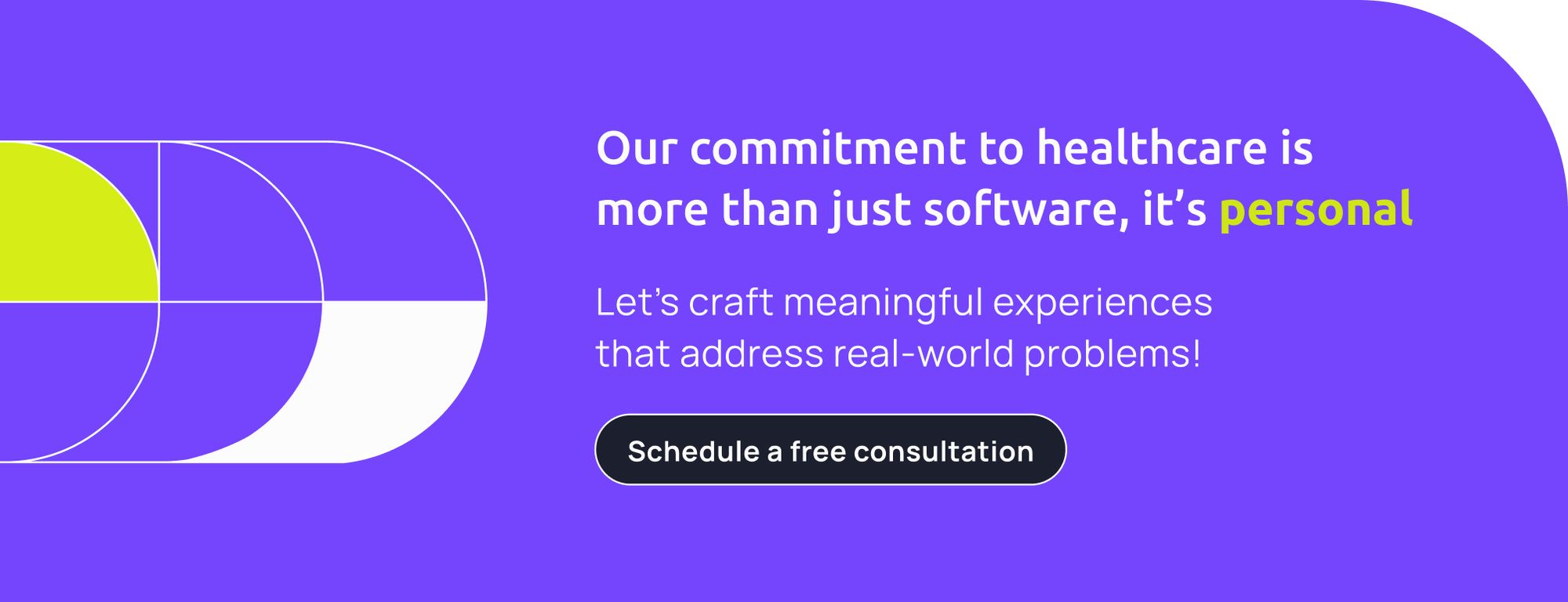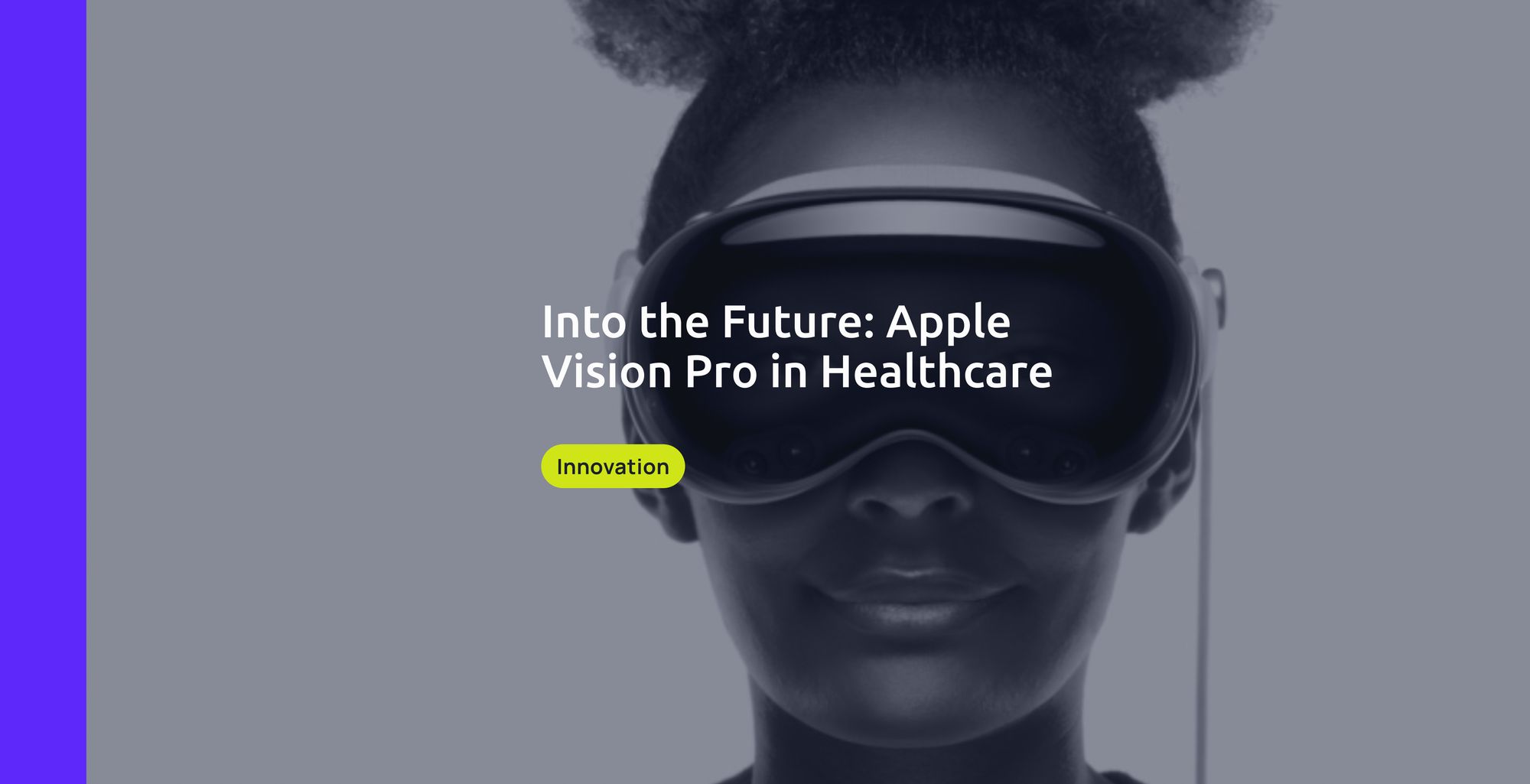The buzz and pressure on the new Apple Vision Pro have been high for a few days since the bitten apple brand made its awaited launch on February 2nd. Our aim is to provide you with all the necessary information related to the development of augmented and virtual reality headsets in the healthcare industry, which has taken ten years to create. We want to make it easier for you to understand everything about this innovative technology.
We’ll cover its top features, explore its applications in healthcare, explore how (and which) three big health systems in the US are already testing the waters, and finish by discussing the challenges and considerations when placing this avant-garde technology in our industry.
What is Apple Vision Pro
Apple's team refuses to use the term headset. That's why they have come up with the concept of "the first spatial computing device" due to its ability to blend digital content with the physical world.
Three different kinds of experiences can be created with 'VisionOS,' Apple's new operating system designed to support the Vision Pro:
- "Windows" (typical apps floating in space).
- "Volumes" (3D objects that users can inspect, interact with, and view from numerous angles).
- "Spaces" (completely immersive settings for users to explore).
Drilling down a bit further, with the Apple Vision Pro mixed reality headset, you can see immersive fully virtual content in addition to augmented reality stuff overlayed on your surroundings. All of what you see is digital. Apple employs cameras to map out your surroundings and convert them into a digital image enhanced with virtual features for augmented reality entertainment that doesn't make your surroundings disappear. Spicy, huh?
Apple turns off those cameras for a virtual reality experience, which might give you the impression that everything around you has stopped, leaving you free to concentrate just on the content on the headset's screens. The "real" and "immersive" levels can be switched between using an on-device Digital Crown (this is like a small physical dial or button).
Apple Vision Pro eliminates controllers; instead, voice commands, hand gestures, and eye tracking are used to operate the headset. An application can be navigated by looking at it and then opened with a tap of fingers. All it takes to scroll is a quick finger flick. Isn't it quite tripping?
Applications of Apple Vision Pro in Healthcare
Though they didn't invent the smartphone, tablet, or smartwatch, Apple has been known for bringing technology to the mainstream while placing emphasis on innovation, research, and development.
Although virtual reality and augmented reality technologies have numerous potential applications in the fields of medicine and healthcare, there has been limited adoption of VR headsets in these contexts, and the pace of adoption has been slow, to say the least.
But here comes the immersive data visualization and accessibility characteristics of the Apple Vision Pro. They may open up new possibilities for medical professionals and patients alike, from improving mental health therapies to helping surgeons with surgical planning, and transforming telemedicine and medical education and training.
So, let's explore ways in which the Apple Vision Pro might change the way that medicine is practiced today:
Telemedicine how we've never seen it
In an immersive environment, medical professionals might interact with patients and offer a more holistic and interactive consultation experience than in a traditional 2-dimension teleconsultation. Additionally, when paired with artificial intelligence algorithms, the imaging capabilities of the Apple Vision Pro may make it easier to diagnose and monitor a variety of illnesses and conditions remotely. This would allow for prompt interventions and lessen the strain on healthcare institutions.
Mental Health is a promising field
Apple has conducted trials utilizing the Vision Pro to monitor a user's facial expressions in an attempt to identify mental health conditions such as PTSD, sadness, anxiety, and stress. Pupil dilation, external cameras, and eye tracking, in particular, can measure an individual's "affect," a psychological term referring to how they exhibit their emotions.
An impersonal facial expression, sometimes referred to as a "flat affect," may indicate certain mental health issues. When the Vision Pro detects such an issue, it plays sounds and shows appropriate visuals to help the wearer feel better. Researchers have already employed virtual reality headsets to safely expose patients to their fears to diagnose and treat PTSD and phobias.
Surgical Leap Forward
Extreme precision is necessary for surgical procedures, as even the smallest error can have serious repercussions. Because of the device's precise tracking capabilities, surgeons can make better decisions during complex surgeries by accessing real-time information. During surgery, imagine a surgeon can superimpose essential structures, such as blood vessels and nerves, in their field of view.
Additionally, experts and surgeons in distant locations can communicate with each other because of the device's networking features. Surgeons can work together in real-time and get advice from experts worldwide.
Physical Rehabilitation
Applications for virtual rehabilitation and therapy can be developed by utilizing the headset's sophisticated sensors and hand-tracking capability. Rehab programs might be made much more effective and patient involvement could rise if patients have immersive settings for interactive exercises, real-time feedback, and movement tracking.
Assisting Diagnosis
With exceptional video and image quality, healthcare providers can conduct more thorough examinations and gain a more comprehensive understanding of anatomy and potential medical conditions.
Medical Training
AVP (Apple Vision Pro) technology can provide detailed 3D models of the human body, enabling medical students to explore and understand anatomy more interactively and dynamically. This anatomy visualization also allows trainees to practice surgeries, patient examinations, and other critical tasks in a controlled and immersive environment. Medical students can also engage in remote training sessions and collaborative learning experiences. Lastly, replicating hyperrealistic emergency scenarios can provide medical personnel with a virtual environment to practice and refine their responses to critical situations.
Apple Vision Pro & the Healthcare System
The buzz around Apple Vision Pro has reached the healthcare system and they’ve definitely been moving quickly! Three healthcare systems across the US are embracing the technology of spatial computing: Cedars-Sinai, Boston Children’s Hospital and Sharp Healthcare. Let’s see what they are plotting:
Xaia by Cedars-Sinai
At Cedars-Sinai, physician-scientists have developed a cutting-edge approach that uses immersive virtual reality and generative artificial intelligence to assist mental wellness. This behavioral health software is called Xaia, which stands for eXtended-Reality Artificially Intelligent Ally, and allows patients to participate in a type of therapy where they communicate with a computer program. Users do not need to provide any PHI, and the software complies with HIPAA regulations.
This therapy is meant to be soothing, and it happens in serene locations like on a sunny beach or along a brook. Patients can also engage in deep breathing exercises and meditation during these sessions.
“To our knowledge, this is the first time mental health therapy has been studied using generative artificial intelligence within immersive virtual reality,” said Brennan Spiegel, MD, MSHS, professor of Medicine, director of Health Services Research at Cedars-Sinai.
CyranoHealth by Boston Children's Hospital
The Immersive Design Systems team at Boston Children’s Hospital, in collaboration with Apple, developed the CyranoHealth app.
The app allows nurses and other medical workers to practice using medical equipment in a safe and stress-free environment, or even in a virtually simulated chaos of a busy hospital, facilitating the learning and development of critical skills. The CyranoHealth app can help medical personnel become more competent and confident by providing hands-on experience without the risk of negative real-world outcomes, improving patient care.
By ensuring that healthcare professionals are well-prepared and at ease with new equipment before it is incorporated into their practice, this feature may prove invaluable in addressing workforce concerns and lowering burnout among healthcare workers.
“CyranoHealth represents a significant leap forward in healthcare training blending technology and medicine to create a future-ready workforce," John Brownstein, PhD, chief innovation officer of Boston Children's Hospital told Becker’s Hospital Review.
Sharp HealthCare & Epic partnership
Sharp HealthCare, based in San Diego, bought 30 AVP devices to explore a range of applications. In collaboration with Epic, the leading provider of EHRs, the company is researching and developing healthcare applications with its Prebys Innovation and Education Center. The seven-hospital system uses the center, which debuted in April 2023, as a canvas for innovative ideas.
The health system has assembled a panel of physicians and software developers to evaluate the device's spatial computing capabilities. Sharp's system leadership sees promise in combining data from the EHR, diagnostic imaging, and other clinical systems into an immersive application for physicians, even if the company hasn't officially planned any Apple Vision Pro pilots.
Cautions and Considerations when Applying Apple Vision Pro and VR in Health Treatments
In terms of the hardware and technology, the Vision Pro has generally wowed the audience. Nonetheless, AVP faces a few obstacles on the road to general acceptance.
- Economic barrier: Its high price, $3.499, is one major barrier since it may be out of reach for both individuals and institutions to take it at scale.
- Ease of use: Despite the fact that with Apple Vision Pro, over a dozen cameras and sensors map your surroundings while monitoring your hand and eye motions, there are concerns regarding the device's real functionality and the ease of use of the gesture-based interface.
- Physical Wellbeing: The device’s 1.5-pound weight and posture during use could potentially contribute to neck and back problems and be problematic for prolonged use, reducing its usefulness in some treatments that may demand extended use periods.
- Security & Privacy Matters: When it comes to the gadget's protection, Apple is introducing a new biometric authentication system, Optic ID, which scans each person's unique iris pattern with infrared lights and cameras. Despite this high-tech authentication, data security and privacy are critical, particularly when handling sensitive patient data. As these technologies advance, regulatory gaps expand, and finding the right balance between innovation and moral considerations will become increasingly important.
- Planning and Training are Key: Furthermore, planning and preparation are essential for Apple Vision Pro's integration with healthcare systems' workflows. Healthcare establishments must guarantee that their personnel have sufficient training to utilize the device's capabilities proficiently and securely.

Closing remarks
It’s time to take mixed reality seriously in healthcare.
To fully realize the potential of these technologies, we must start using and treating these innovations intently. What's happening with Apple's Vision Pro in healthcare may not be a passing fad, but a catalyst.
The era of testing is not and will not be over. Still, as a peer-reviewed paper from Nature Digital Medicine, which endorses their safety and benefits, showed, its positive effects are already turning into facts.
The question is not whether we can invest in these innovations but whether we can afford not to. The real cost is not today's expenses but tomorrow's missed opportunities.



